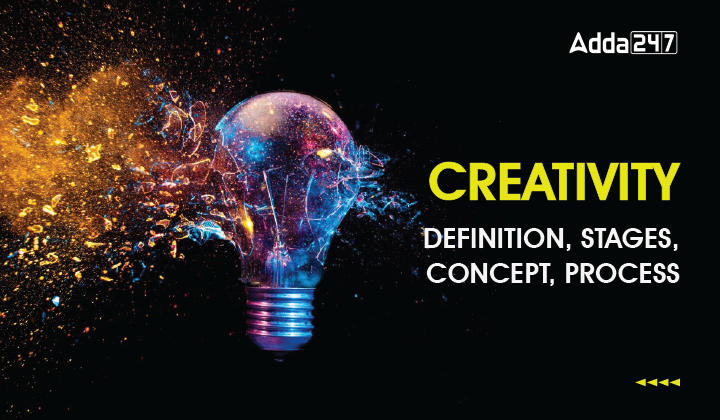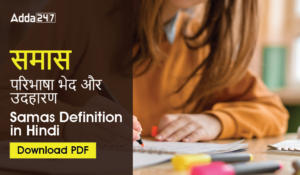Table of Contents
Stages of Creativity is an important topic of Child Development and Pedagogy (CDP) which comes in teaching exams i.e. UGC NET, CTET, HTET, KVS and others. Here, we are going to explain the Phases and Stages of Teaching in detail which helps students with Exam Preparation.
The topic of creativity in the CTET (Central Teacher Eligibility Test) exam may explore the importance of fostering creativity in the classroom and its role in enhancing the overall learning experience for students. Candidates may be asked to discuss various aspects related to creativity, its significance in education, and strategies to promote creativity among students. Here is a possible outline for an essay or response on the topic
What is the Stages of Creativity?
Creativity: Definition, Type, Concept, Process: Creativity, the most advanced thought process, creativity, involves the production of uncommon and novel ideas that are highly relevant to the situation. Creativity comes in recruitment exams in the form of stages. Creativity is the ability to generate, create, or discover new ideas, solutions, and possibilities. Here we are going to generate and discover definitions, Types, Concepts, Process of creativity in an easy way.
Stages of Creativity/ रचनात्मकता
Concept of creativity/ रचनात्मकता की अवधारणा
Creativity means discovering new relationships between ideas. Creativity is a wonderful ability that helps a man to solve the most complex problems of life and to make life comfortable. Creativity gives a new fascinating turn to humanity and to a Nation. Creativity is related to Cognitive Operations. The Cognitive operations include Divergent Cognition, Convergent productions, Recognition of Ideas, Judging, and knowing. Creativity is a specific scientific process of thinking that yields solutions to problems.
रचनात्मकता का अर्थ है विचारों के बीच नए संबंध की खोज करना। रचनात्मकता अद्भुत क्षमता है जो मनुष्य को जीवन की सबसे जटिल समस्याओं को हल करने और जीवन को आरामदायक बनाने में मदद करती है। रचनात्मकता मानवता और एक राष्ट्र के लिए एक नया आकर्षक मोड़ देती है। रचनात्मकता संज्ञानात्मक संचालन से संबंधित है। संज्ञानात्मक कार्यों में अपसारी संज्ञान, अभिसारी प्रोडक्शंस, विचारों को पहचानना, निर्णय लेना और जानना शामिल हैं। रचनात्मकता सोच की एक विशिष्ट वैज्ञानिक प्रक्रिया है जो समस्याओं का समाधान करती है।
Guilford has described five mental ideas of creativity/
गिल्डफोर्ड ने रचनात्मकता के पांच मानसिक विचारों का वर्णन किया है:
- Cognition/ संज्ञान
- Convergent Thinking/ अभिसारी चिंतन
- Divergent – thinking/ अपसारी चिंतन
- Memory/ स्मृति
- Evaluation/मूल्यांकन
Views of H. J. Eyesenck – 1972: “Creativity is the ability to see new relationships, to produce unusual ideas and to deviate from traditional patterns of thinking.”
एच. जे. ईसेनक के विचार- 1972: “रचनात्मकता नए संबंधों को देखने, असामान्य विचारों को उत्पन्न करने और सोच के पारंपरिक पैटर्न से विचलित करने की क्षमता है”.
The following aspects are common to all/
निम्नलिखित पहलू सभी के लिए सामान हैं:
- Creativity means creative thinking.
- Creativity is a process.
- Creativity is a person’s quality and virtue.
- Creativity yields new ideas.
- Creativity is a kind of interaction.
- रचनात्मकता का मतलब रचनात्मक सोच है।
- रचनात्मकता एक प्रक्रिया है।
- रचनात्मकता एक व्यक्ति का गुण और खूबी है।
- रचनात्मकता नए विचारों को जन्म देती है।
- रचनात्मकता एक प्रकार की अंतःक्रिया है
Nature of Creativity रचनात्मकता की प्रकृति
Many studies have been conducted on Creativity. It can be described in the following manner on the basis of the findings, yielded by the studies :
रचनात्मकता पर कई अध्ययन किए गए हैं। यह अध्ययनों द्वारा प्राप्त निष्कर्षों के आधार पर निम्नलिखित तरीके से वर्णित किया जा सकता है:
- Creativity is not a product; it is a factor or an ability.
- Creativity is the result of divergent thinking.
- Creativity is a way of thinking. It is not a synonym for intelligence.
- Creativity is Goal–directed. It is useful for the individual as also for a group of individuals and for the society.
- The ability to create depends on the acquisition of Accepted knowledge.
- Creativity is a kind of restrained imaginative inspiration that attains to some achievement.
- Creativity, whether it is oral written, abstract or concrete, is, in any case, unique.
- रचनात्मकता कोई उत्पाद नहीं है; यह एक कारक या एक क्षमता है।
- रचनात्मकता विपरित सोच का परिणाम है।
- रचनात्मकता सोचने का एक तरीका है। यह बुद्धिमत्ता का पर्याय नहीं है।
- रचनात्मकता लक्ष्य – निर्देशित है। यह व्यक्तियों के लिए और व्यक्तियों के समूह के लिए और समाज के लिए भी उपयोगी है।
- बनाने की क्षमता स्वीकृत ज्ञान के अधिग्रहण पर निर्भर करती है।
- रचनात्मकता एक प्रकार की संयमित कल्पनात्मक प्रेरणा है जो किसी उपलब्धि को प्राप्त करती है
- रचनात्मकता, चाहे वह मौखिक हो या लिखित हो, अमूर्त या ठोस हो, किसी भी मामले में अद्वितीय है
Characteristic of Creative Children रचनात्मक बच्चों की विशेषता
The charaterstic of Creativity has been given below :
रचनात्मक बच्चों की मुख्य विशेषताएं नीचे दी गई हैं:
- Curiosity /जिज्ञासा
- Flexibility / लचीलापन
- Original Thinking / मूल सोच
- Independent Judgement / स्वतंत्र निर्णय
- Concentrated Attention / एकाग्र चित्त
- Complex Thinking / जटिल सोच
- High Energy Level / उच्च ऊर्जा स्तर
- Risk – taking Tendency/ जोखिम लेने की प्रवृत्ति
- Courageous / साहसी
- Power of Imagination / कल्पना की शक्ति
- Desire for Superiority / श्रेष्ठता की इच्छा
- Far Sightedness / दूर दृष्टि
The Process of Creativity रचनात्मकता की प्रक्रिया

- The Stage of Preparation: This is the first stage of creativity. At this stage a person facing a problem defines the problem. He collects material with regard to the problem, indulges in imagination and sets about working according to the nature of the problem.If possible he makes changes in the strategy, he has planned to solve his problem. He doesn’t slacken his efforts in achieving the solution of the problem. After having made persistent endeavors, if he realizes that the solution to the problem is not possible, a feeling of frustration sets in his mind and he stops working on the problem for sometimes.
तैयारी का चरण: यह रचनात्मकता का पहला चरण है। इस अवस्था में समस्या का सामना करने वाला व्यक्ति समस्या को परिभाषित करता है। वह समस्या के संबंध में सामग्री एकत्र करता है, कल्पना में लिप्त होता है और समस्या की प्रकृति के अनुसार काम करने के बारे में निर्धारित करता है। यदि संभव हो तो वह रणनीति में बदलाव करता है, अपनी समस्या को हल करने की योजना बनाता है। वह समस्या के समाधान को प्राप्त करने में अपने प्रयासों को धीमा नहीं करता है। लगातार प्रयास करने के बाद, अगर उसे पता चलता है कि समस्या का समाधान संभव नहीं है, तो उसके मन में निराशा की भावना पैदा होती है और वह कभी-कभी समस्या पर काम करना बंद कर देता है
- The Stage of Incubation : Incubation is the second stage of creativity. At this stage the person facing the problem does not think about the problem. He engages himself in other activities. At this stage the person concerned does not work on the problem consciously – The problem goes from the conscious mind into the unconscious mind. But the individual keeps getting hints regarding solution of the problem. The ideas regarding the solution of the problem keep surfacing from the unconscious mind to the conscious mind.
उद्भवन की अवस्था: ऊष्मायन रचनात्मकता का दूसरा चरण है। इस अवस्था में समस्या का सामना करने वाला व्यक्ति समस्या के बारे में नहीं सोचता है। वह खुद को अन्य गतिविधियों में संलग्न करता है। इस अवस्था में संबंधित व्यक्ति सचेत रूप से समस्या पर काम नहीं करता है। समस्या चेतन मन से अचेतन मन में चली जाती है। लेकिन समस्या के समाधान के बारे में व्यक्ति को संकेत मिलते रहते हैं। समस्या के समाधान के बारे में विचार अचेतन मन से चेतन मन तक उभरते रहते हैं
- The Stage of Illumination : At this stage the individual confronted with the problem suddenly awakens to the solution of the problem (The solution of the problem suddenly dawns on him). The solution can present itself in any form. Most thinkers believe that the creative ideas dawn on a person suddenly. Archimedes found a solution to a problem facing him suddenly while bathing. After the sudden illumination, the creative thinking does not stop but continues.
प्रबोधन की अवस्था: इस स्तर पर समस्या का सामना करने वाला व्यक्ति अचानक समस्या के समाधान के लिए जाग जाता है (समस्या का समाधान अचानक उस पर हावी हो जाता है)। समाधान स्वयं को किसी भी रूप में प्रस्तुत कर सकता है। ज्यादातर विचारकों का मानना है कि रचनात्मक विचार किसी व्यक्ति पर अचानक हावी हो जाते हैं। आर्किमिडीज़ को नहाते समय अचानक सामने आ रही एक समस्या का हल मिल गया। अचानक रोशनी के बाद, रचनात्मक सोच बंद नहीं होती है लेकिन जारी रहती है।
- The Stage of Verification : This is the final stage of Creative thinking. At this stage the solution that has suddenly dawned is subjected to verification. An endeavor is made to find out if the solution is right or wrong. If the solution proves wrong or not useful, the process to find the solution restarts. Sometimes changes have to be effected in the solution. The solution is subjected to verification again and again, and when proved right is put to use.The stage described above are not independent of one another. The creative work is possible only with the help of these four stages.
सत्यापन की अवस्था: यह रचनात्न्मक चिंतन का अंतिम चरण है। इस स्तर पर समाधान जो अचानक कम हो गया है, सत्यापन के अधीन है। समाधान सही है या गलत इसका पता लगाने का प्रयास किया जाता है। यदि समाधान गलत या उपयोगी साबित नहीं होता है, तो समाधान को खोजने की प्रक्रिया फिर से शुरू होती है। कभी-कभी समाधान में परिवर्तन करना पड़ता है। समाधान को बार-बार सत्यापन के अधीन किया जाता है, और जब सही साबित हो जाता है तो उपयोग करने के लिए रखा जाता है।
Measurement of Creativity
Within the category of divergent thinking, Houtz and Krug (1995) present the Torrance Test of Creative Thinking (TTCT) (Torrance 1966), The Wallach and Kogan Tests, The Guilford Battery. The most widely used test on creativity is the Torrance Test of Creative Thinking (TTCT). It is also the one that has the most extended research on their reliability and validity (Kim 2006). This test has been translated into more than 30 languages and it is used in different places as a tool to assess creative potential. It is based on Guilford’s Structure of the Intellect (SOI) battery that included some measures of divergent thinking. Thus, it measures creativity through divergent thinking.
Creativity : Definition, Stages, Concept, Process PDF
Stages of Creativity PDF Notes
Candidates preparing for Teaching Exams can easily access the Stages of Creativity Notes PDF file from the link provided below. They can refer to the PDF as a reference during preparation and most importantly during revisions.
Stages of Creativity: Definition, Stages, Concept, Process PDF




 समुद्र का पर्य�...
समुद्र का पर्य�...
 उपमा अलंकार: पर�...
उपमा अलंकार: पर�...
 समास परिभाषा, भ�...
समास परिभाषा, भ�...














